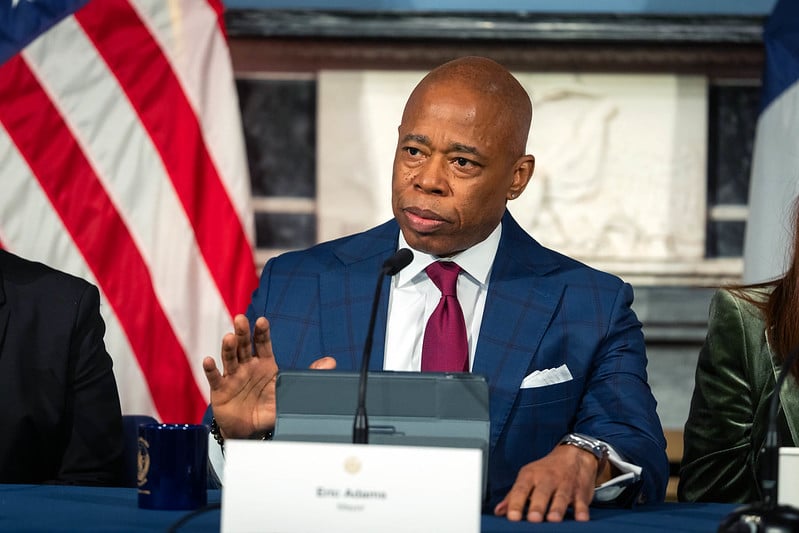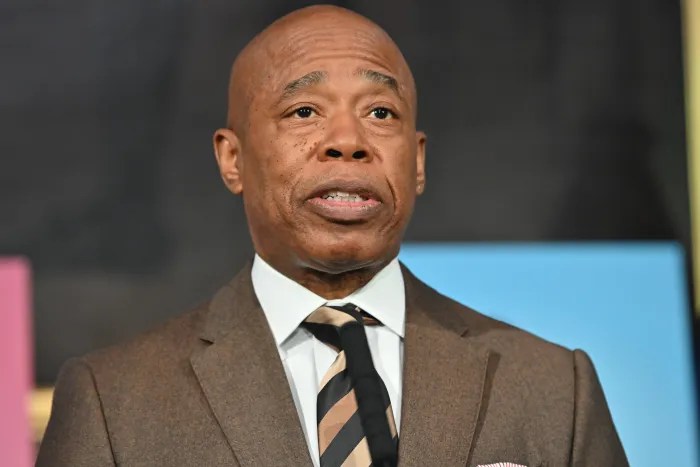Mayor Eric Adams on Tuesday insisted his new restrictions on buses carrying migrants to New York City is “not backfiring” after drivers began dropping off recent arrivals at New Jersey train stations over the weekend, even as he indicated his team is looking at ways the policy can be tweaked.
Over New Year’s weekend, bus operators began dropping migrants off at commuter rail stations in the Garden State, from which the newcomers then traveled to the Big Apple, after Adams last week signed an executive order placing strict limits on when and how charter buses can drop off migrants in the city. The buses of migrants, many of which are being sent to the five boroughs by Republican Texas Gov. Greg Abbott, have been arriving here for the better part of two years.
The mayor’s new restrictions require bus operators to provide the city with 32 hours advance notice, with drop-offs only permitted at city-approved locations. Additionally, the bus companies can only drop the immigrants off between the hours of 8:30 a.m. and noon.
The rules were instituted in response to a recent surge in buses arriving from Texas at late night hours without any notification or coordination with city officials, according to City Hall. The buses that showed up over the weekend dropped migrants off at train stations in New Jersey towns including Edison, Fanwood, Secaucus and Trenton, according to the Jersey City government.
Hizzoner pushed back on the idea that the executive order is not working as intended when questioned about it by a reporter during his weekly off-topic news conference. He said he was already aware of bus operators, allegedly at Abbott’s behest, using the same tactics to get around similar restrictions in Chicago before issuing his own executive order.
“The executive order is not backfiring,” Adams said. “We spoke with our colleagues in Chicago who told us that this is what Gov. Abbott did in Chicago. He started dropping people miles away and telling them that ‘you are in Chicago proper.’ And so, we are continually anticipating the move of his actions.”
But, at the same time, Adams left open the possibility that he could alter the executive order to compensate for Abbott’s change in tactics.
“We are not willing to be just stationary, if we have to change the EO (executive order) we’ll change the EO,” Adams said. “This is who we’re dealing with right now, we’re looking at a person who is focused on disruption.”
The mayor’s chief counsel, Lisa Zornberg, took direct aim at Abbott, labeling his campaign to send migrants to the city as “bonkers.”
“Since we issued that executive order, not one bus from Texas has complied, not one,” Zornberg said. “There is a strategy, which we believe is being directed by the state of Texas, to purposely try to evade the executive order.”
Adams also urged leaders of the New Jersey counties where migrants are being dropped off to take executive actions similar to his own. But he insisted the goal of the order is not to encourage other nearby municipalities to do the same but simply to compel Texas and other localities sending buses here to coordinate with his administration.
“The goal of the EO is to coordinate people coming to our city, so that we can utilize our manpower better, so that we can utilize how to have space for people,” the mayor said. “That’s the goal. The goal is not to have this cascade of EOs go out, that’s a byproduct.”
Additionally, the mayor said he is planning to meet with New Jersey Gov. Phil Murphy in the coming days to see if there is “room for collaboration.”
The latest spat between Adams and Abbott comes as the city continues to receive thousands of migrants every week. Over 160,000 mostly Latin American and West African migrants have come to the city since April of 2022, with nearly 70,000 living in city-run shelters.
The mayor has long said the city’s shelter system is at its breaking point and cannot continue providing an endless stream of migrants with shelter and services without significant financial and logistical support from Washington DC, which has so far not come.
“I think that we’re making a big mistake that we’re looking at the sink that’s overflowing and not the faucet,” Adams said. “The national government needs to fix this problem.”






































